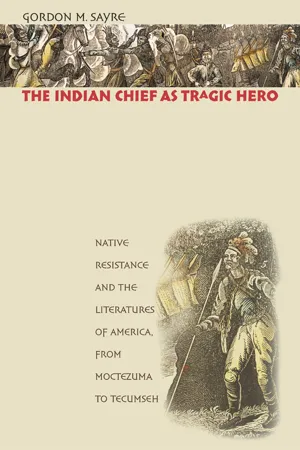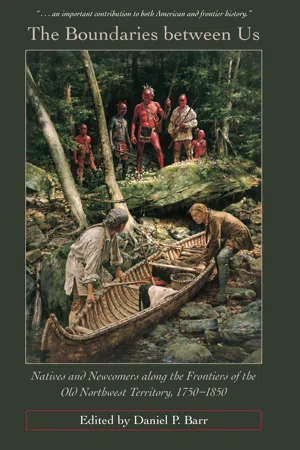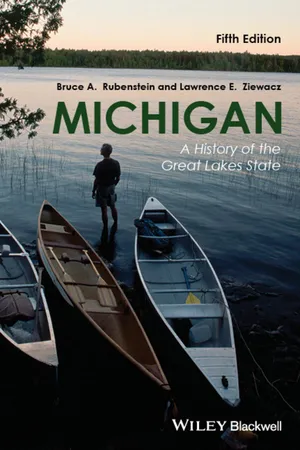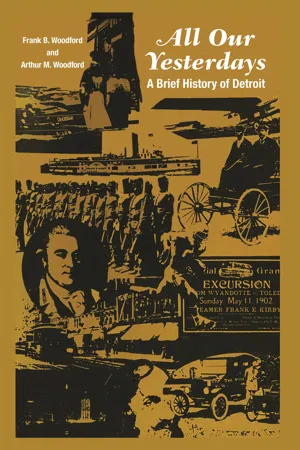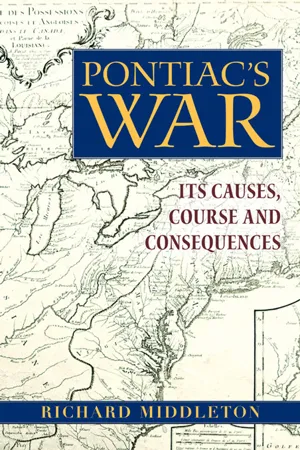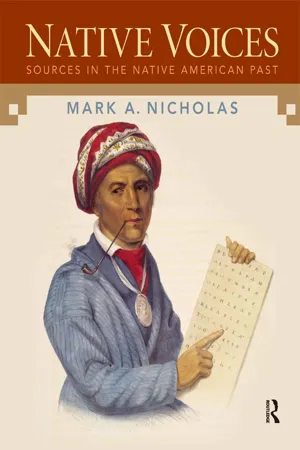History
Pontiac's War
Pontiac's War was a conflict that took place from 1763 to 1766 in the Great Lakes region of North America. It was led by the Ottawa chief Pontiac and aimed to drive British forces out of the area. The war resulted in a significant loss of life and ultimately led to the Proclamation of 1763, which restricted colonial settlement west of the Appalachian Mountains.
Written by Perlego with AI-assistance
Related key terms
9 Key excerpts on "Pontiac's War"
- eBook - ePub
Encyclopedia of the Atlantic World, 1400–1900
Europe, Africa, and the Americas in an Age of Exploration, Trade, and Empires [2 volumes]
- David Head, David Head, David Head(Authors)
- 2017(Publication Date)
- ABC-CLIO(Publisher)
Called King Philip by the English colonists, the Wampanoag sachem Metacomet (ca. 1638–1676) forged an alliance among the Abenaki, Narraganset, Mohawk, Nipmuc, and Wampanoag to resist English settlement. Following a campaign of brutal fighting during the conflict between Native Americans and New England colonists, known as King Philip’s War (1675–1678), Metacomet was killed in battle. The English cut off his head, arms, and legs, and displayed the head on a pike.Native polities grew more powerful in the eighteenth century by playing European powers off of one another. British victory in the Seven Years’ War (1754–1763) shattered this balance of power and initiated a wave of pan-Indian resistance to British land claims. Beginning at refugee camps in the 1740s and gaining momentum after the 1760s, Native Americans throughout the eastern woodlands took part in a religious revival that emphasized a unified “Indian” identity that could be rejuvenated through a return to “traditional” rituals and a rejection of European commodities. Ottawa leader Pontiac drew inspiration from Delaware prophet Neolin’s message of revitalization to spearhead war on the British in the Great Lakes region in 1763. Drawing on the military experience of the Seven Years’ War, bands or tribes from the Great Lakes, Illinois, and Ohio regions joined the conflict in 1763 and 1764, laying siege to forts Detroit and Pitt—where British soldiers infamously responded by giving smallpox-infected blankets to Delaware emissaries—and attacking British supply routes to the interior. Neither side of the conflict achieved all of its ambitions, and the war ended in a series of uneasy peace agreements between 1764 and 1766. Importantly, though, British officials recognized the Native Americans as separate nations, powerful in their own right.Different patterns shaped the interactions between Spanish settlers, the native peoples of New Spain and South America, and the Creole elites who increasingly stood at the center of Latin American politics. Where native polities in North America retained a measure of sovereignty and white settler communities constructed national identities in opposition to their Native American neighbors, indigenous peoples to the south were largely folded into the colonial order: settlers appropriated the pre-Columbian past into their national identities while attempting to silence or ignore Native American subjects. Indigenous peoples frequently challenged this order, however, by uniting with Mestizo peasants in widespread revolt. Andean peasants and indigenous groups rallied in the Tú pac Amaru and Tú pac Katari uprisings in the 1780s, for example, and a similar indigenous-Mestizo alliance took an important part in the 1810 rebellion of Miguel Hidalgo and José - eBook - ePub
The Indian Chief as Tragic Hero
Native Resistance and the Literatures of America, from Moctezuma to Tecumseh
- Gordon M. Sayre(Author)
- 2006(Publication Date)
- The University of North Carolina Press(Publisher)
The Middle Ground (1991), his influential study of Native American communities and French and English colonists in the Great Lakes region from 1650 to 1815. His title refers not to the mixture of races but to “a place in between: in between cultures, peoples, and in between empires and the non-state world of villages” (x). White’s concept of middle ground is built on practices established between the natives and the French and only sporadically adopted later by the British and Americans. Although articulated in a cultural rather than racial paradigm, his analysis of the causes of Pontiac’s rebellion is really not very far from Parkman’s, as it turns on the assimilation of or resistance to native symbolic and material exchange by colonial traders and soldiers. For example, White explains how English officials often refused to compensate the native families of victims murdered by Europeans or by people from other villages, a judicial practice that helped prevent cycles of vengeance and maintain alliances and trading relationships and that the French had carefully cultivated since the early 1600s. White also explains that Jeffrey Amherst, the British general who led the administration of Indian affairs in the western territories from 1761 to November 1763, refused to honor the native customs of diplomatic gift giving as the French had done. Amherst “blustered into Indian affairs with the moral vision of a shopkeeper and the arrogance of a victorious soldier” (257); he insisted on a petty capitalist doctrine that Indians must be paid only for services rendered, not honored or conciliated with presents. The British indulged in an imperial fantasy that native people should play by the rules that governed subaltern classes in British society. Amherst’s subordinate, Major Henry Gladwin, who as commandant at the besieged fort of Detroit was Pontiac’s primary adversary, wrongly believed that he had no need for the Indians. And for a year, in 1763–64, British forces paid dearly for this mistake.The uprising of 1763 included coordinated attacks by warriors of many Indian nations: the Seneca in western New York, the Shawnee and Miami of Ohio, the Ojibway and Ottawa of northern Michigan, the Illinois of the land later named for them. Of course the region had seen large-scale conflicts and multiethnic fighting forces before—large French-organized attacks on the Iroquois had occurred in the late seventeenth century, for example—but this may have been the first time that so many tribes acted in concert without the direct instigation of a colonial power. The precise importance of Pontiac’s leadership in this process is uncertain. Parkman gave him a central role as Indian leader while suggesting that the French encouraged the revolt. Howard Peckham in his 1947 history of Pontiac’s war downgraded his importance and presented evidence of some French leadership, while in his 2002 book and in a 1990 article Gregory Dowd restores much of Pontiac’s stature and contends that the Indians acted independently of the French.1The question of Pontiac’s leadership elicits various answers from modern historians, but the answers of eighteenth- and nineteenth-century writers were colored by a pattern of anxiety about native conspiracies. The genesis of the conspiracy was presumed to be either the French or Pontiac, as if mere self-interest were not enough to motivate concerted attacks by “savages” on more than a dozen widely separated forts during the summer of 1763. British officers’ letters were filled with anxious conspiracy theories and rumors of red wampum belts passing among the tribes. Because the tribal identity of native warriors and the dynamics of their allegiances were difficult for the average white observer to ascertain, any band of Indians might appear to be conspiratorial. (In a like manner today, the ignorance of U.S. soldiers and leaders regarding Middle Eastern languages and Muslim sects makes it difficult for the Americans to distinguish terrorists from innocent civilians.) Moreover, many natives saw an advantage in frightening frontier traders by warning of an impending revolt by all the Indians. For example, James Kenny wrote in his journal in January 1763, “We hear that Bill Hickman a Delaware Indian has Informed Paterson and the Inhabitants about Juniata that the Indians intends to break out in a War against us Next Spring; but as we know him to be a Roague and a Horse thief, we judge his report to be more for Self Ends than Truth or Good Will to us, not but what the Mingoes I believe would set on the Western Nations to Strike us if they Could” (184).2 - eBook - ePub
The Boundaries Between Us
Natives and Newcomers along the Frontiers of the Old Northwest Territory, 1750-1850
- Daniel P. Barr(Author)
- 2012(Publication Date)
- The Kent State University Press(Publisher)
3
“We Speak as One People”
Native Unity and the Pontiac Indian Uprising
DAVID DIXONIn the mid–nineteenth century Americans embraced an ideology that summoned them to expand their moral virtues and political institutions across the continent. The public eagerly heralded testaments supporting this notion of “Manifest Destiny” and insisted that any impediments to progress and civilization must be swept aside. It was during this time that New England historian Francis Parkman introduced The Conspiracy of Pontiac and the Indian War after the Conquest of Canada, an epic narrative concerning the Woodland Indian conflict that erupted in the aftermath of the Seven Years’ War in America. In this classic account, Parkman places the Ottawa leader, Pontiac, as the central figure who magically orchestrates a powerful and united Pan-Indian Confederation intent on eliminating Anglo-American presence west of the Appalachian Mountains. Parkman could not have picked a better story to relate to an American public bursting with a sense of its own destiny to expand from the Atlantic to the Pacific.As Parkman’s tale develops, the English are almost overwhelmed by a cunning and loutish foe who will stop at nothing to halt the progress of civilization. The Indians are whipped into a frenzy by the charismatic leadership of Chief Pontiac, who artfully organizes a confederation of all the tribes of the Northeast. The English, who have no ill designs other than to raise their crops and families in the austere wilderness, are completely caught off guard as the Indian horde rolls over the forts that are situated along the frontier to protect them. Only Forts Detroit and Pitt are able to withstand the ferocious onslaught. Though outnumbered, the garrisons at these two beleaguered outposts somehow manage to hold out against the barbaric menace that surrounds them. Through courage and determination the British and Americans finally prevail and defeat the bloodthirsty Indians. In this compelling and dramatic chronicle Parkman provides his readers with an instructive lesson: in the end civilization will always triumph over savagery. - eBook - ePub
- Jeremy Black, Jeremy Black(Authors)
- 2005(Publication Date)
- Routledge(Publisher)
He scorned the ability of Indian warriors, and was determined to secure by force the Great Lakes region, ceded by France in 1763, without consulting its Indian inhabitants. On the one hand, he severely reduced expenditures for presents to the Indians, which they considered to be the tangible sign of good will; on the other, he spread a number of inadequately garrisoned forts across the region, which provoked Indian hostility without overawing them. The result was the 1763 uprising known as Pontiac’s rebellion, which shook Britain’s grip on the region. In two years of war the Indians fought the British Empire to a draw. 36 Some eighteenth-century military commanders, such as John Burgoyne and Barry St. Leger, blamed their Indian allies unfairly for their lack of success. Some modern historians have also disparaged the Indians as unreliable allies and useless fighters. Often these writers fail to appreciate the qualities of Indian warriors, who had no interest in fighting in the European style. These critics also assume that the Indians were passive clay who could be “used”. 37 American Indians seldom served as mercenaries; they were not sepoys. Instead they fought for motives of their own and in their own way. They had to be convinced that their ally’s cause justified their participation. The Western Abenakis of Vermont were thus prepared to fight English settlers during the Seven Years’ War, whether or not the French Governor wanted them to. But they were not enthusiastic about participating in the American War of Independence - eBook - ePub
Michigan
A History of the Great Lakes State
- (Author)
- 2017(Publication Date)
- Wiley-Blackwell(Publisher)
Defeat was a bitter blow for Pontiac. He could not understand how his old friends, the French, could ally themselves to the British merely for trade, and he was convinced that his Indian allies had deserted him simply because he had not gained a quick victory. Never did Pontiac realize that by keeping the siege, even though victory was impossible, he was inflicting suffering and starvation among his people.In October 1764, Colonel John Bradstreet held a council with the Ottawa, Chippewa, Miami, Huron, and Potawatomi in which the Indians agreed to acknowledge the British king as their Father, and, in return, the British pledged to pardon Pontiac and remove illegal settlers from Indian territory. To encourage the Indians to abide by this agreement, a force of British soldiers under the command of Colonel Henry Bouquet was sent to Detroit from Fort Pitt.In 1766 Sir William Johnson hosted a meeting of Ottawa, Huron, and Chippewa at Oswego, at which their chiefs and headmen, including Pontiac, agreed to conform to the stipulations of the 1764 agreement. Resigned to life amid the British, Pontiac returned to the Illinois region where he was assassinated in 1769 at Cahokia by an Illinois Indian to avenge Pontiac's murder of an Illinois chief.Proclamation of 1763
On June 8, 1763, in an attempt to avoid further Indian unrest in the new western holdings, the Earl of Shelburne, head of the British Board of Trade, offered a proposal for governing the area. In October the Crown implemented his report, which became known as the Proclamation of 1763. According to its provisions, all settlement beyond the Appalachian Mountains was prohibited and any Indian land east of those mountains could only be sold to settlers by authorized British officials. As a result, a large region, including Michigan, was left as permanent Indian territory and remained under military rule until the passage of the Quebec Act in 1774.In England this policy angered a great many people and pleased very few. Fur‐trading companies wanted the area to remain undeveloped so that their business could continue undisturbed, but they demanded guaranteed right of entry into the area. Land speculators and developers demanded that the territory be opened for immediate settlement, regardless of Indian claims or potential danger. Philanthropists argued that the region should belong exclusively to its Indian owners, while clergymen and imperialists argued the necessity of spreading English civilization to every inhabitant of the new empire. - eBook - ePub
- Armstrong Starkey(Author)
- 2002(Publication Date)
- Routledge(Publisher)
52 Once again the title reflects one’s perspective. Is one looking east or west? Discussion of this event is included in this chapter as the final phase of Indian involvement in the conflict between the French and British empires. Not for the first time, the French and British had concluded a peace without consulting all of the interested parties. The war which lasted from 1763 to 1765 demonstrated that the British would have to make peace with the western Indians as well. Amherst’s Indian policies made this difficult. The British had little understanding of western Indian military and diplomatic issues and lacked the means to impose their will by force. Indeed Pontiac’s significance may lie less in his abilities as a war leader, which were considerable, than in the British need to find a recognizable figure with whom to negotiate. The “Emperor Pontiac” was a British creation.The Treaty of Paris was signed on 10 February 1763 and the British garrison at Detroit was attacked by Pontiac and his followers on 7 May. Detroit was tied to the east by a slender thread of tiny British posts surrounded by militarily superior Indian peoples. These small forts were quickly overwhelmed by their Indian neighbours.53 The Indians, who were on familiar terms with the small garrisons, experienced little difficulty in using ruses to capture or kill the soldiers. Only at Fort Presqu’Isle did the Indians find it necessary to launch a major attack by shooting fire arrows at the blockhouse and digging to undermine its foundation. Detroit and Fort Pitt, defended by large garrisons with artillery, were more formidable objectives. These the Indians placed under siege and urged the garrisons to go home.54 The rising reflected widespread Indian dissatisfaction with British imperial pretensions and policies. While Pontiac played a significant role in the siege of Detroit, he was no more the leader of a unified Indian war effort than had been Philip. Great Lakes Indians and Ohio Indians had different motives in going to war and there were divisions and mistrust among Indian communities over the decision to fight. As was often the case, young war leaders prevailed over the advice of older chiefs. Great Lakes Indians, far removed from the pressure of trans-Appalachian white settlement, seem to have envisaged the restoration of the benign French alliance. While they received encouragement in this hope from French traders and settlers, French garrisons in the west did not intervene. Letters from the French commander in Illinois urging the Indians to make peace disheartened the besiegers of Detroit.55 - eBook - ePub
All Our Yesterdays
A Brief History of Detroit
- Frank B. Woodford, Arthur M. Woodford(Authors)
- 2017(Publication Date)
- Wayne State University Press(Publisher)
This state of affairs led to the most dramatic and best known event in Detroit’s long history, a bloody Indian uprising called Pontiac’s Conspiracy or Rebellion. The Pontiac who gave his name to the affair had met Major Rogers at Cleveland. A cruel and wily warrior, he was also something of a statesman. At least he was one of the few Indian leaders who understood that only by united action on the part of all tribes could sufficient strength be mobilized to challenge successfully the white interlopers. So Pontiac developed a plan of confederation and during most of 1762 traveled long distances seeking the cooperation of far distant tribes—the Chippewa, Shawnee, Delawares, Miami, Potawatomi, and Hurons. He proposed that these people join with his own Ottawas, and that each select and be responsible for the capture of a single fort or settlement. At an agreed upon time each tribe would rise simultaneously and by surprise or treachery hit its prescribed target. The attacks were to be simultaneous so the English garrisons would be unable to go to the aid of each other. By threat and coercion Pontiac enlisted many of the western tribes, and by the spring of 1763 he was ready. He summoned a big council which was held on the Ecorse River below Detroit in April and final instructions were given. Pontiac reserved for himself the principal fort—Detroit. His first step was to move his village from the Canadian shore at Walkerville, across from the lower end of Belle Isle, to the American side. He set up his encampment on the farm of Baptiste Meloche on the east side of Parent’s Creek. The location today is approximately at Lieb and Wight streets a short distance west of the Belle Isle bridge. Some of the ground may now be occupied by the huge Parke, Davis & Company plant.Pontiac had a worthy foe to contend with, the British Commandant Major Henry Gladwin of the 80th Light Armed Foot who had been sent to Detroit with a troop detachment. He had arrived September 3, 1761, superseding Campbell who remained as second in command. Gladwin was a professional soldier to the core, stolid and unimaginative, but completely reliable. He was of the stiff-upper-lip carry-on-old-chap type that built the British Empire and permitted no nonsense from the lesser breeds within the imperial borders. Rudyard Kipling would have loved Henry Gladwin. Pontiac definitely did not. - eBook - ePub
Pontiac's War
Its Causes, Course and Consequences
- Richard Middleton(Author)
- 2012(Publication Date)
- Routledge(Publisher)
Nevertheless, Pontiac was by no means inactive during this period. According to Menominee tradition, he visited the Milwaukee some time in the fall of 1762 or early spring of 1763 for a grand council, where he introduced the Wisconsin peoples to Neolin’s vision of a Native America free of white intrusion, including apparently the French. “It is now in our power to force the whites back to their original settlements.” “We must all join in one common cause, and sweep the white men from our country.” Only then could they be “happy … having nothing more to do with the hated race.” The native peoples had no need of the European peoples, “as we have an abundance of game in our forests—our rivers and lakes teem with all kinds of fish, fowl and wild rice.” They could accordingly “live as did our forefathers” and be a happy people once more. 5 Two factors now altered opinion sufficiently to allow Pontiac to launch an attack early in May 1763. One was the news of peace between Britain and France involving the surrender of their country to their former enemy. There was a widespread belief that the terms which the British were promulgating at Detroit were not credible. As John Rutherford, an early captive, commented shortly, the Canadians “could not bring themselves to believe that Le Grand Monarch would ever cede their country to Great Britain and they still flattered themselves that if they could excite the savages to maintain the war against us for a little while, a reinforcement might come to their assistance from France.” 6 The native people in any case needed little encouragement to accept these views, following the promises of Kerlérec the previous year. Both groups accordingly concluded that the declaration by the British was a stratagem to conceal the arrival of a French army and fleet at Quebec and New Orleans - eBook - ePub
Native Voices
Sources in the Native American Past
- Mark Nicholas(Author)
- 2016(Publication Date)
- Routledge(Publisher)
Lord Jeffery Amherst took control of the British frontier after the defeat of French and Indian forces in the Seven Years’ War (1756–1763). Defeat, from the Indian perspective, came at a huge cost. Native peoples throughout the Ohio and Great Lakes territory could no longer play the British and French off of each other to their own benefit. In retaliation against the British, who handled Indian relations poorly, Pontiac and his pan-Indian alliance struck with raw ferocity, destroying nearly every British fort along the frontier. Amherst looked for a solution. In the following excerpts, an exchange of correspondence with Colonial Henry Bouquet, Amherst suggests the use of smallpox as a way to end the Indian resistance movement. Whether or not Amherst and his troops actually infected native peoples with smallpox remains a topic of debate among historians.
Index pages curate the most relevant extracts from our library of academic textbooks. They’ve been created using an in-house natural language model (NLM), each adding context and meaning to key research topics.

